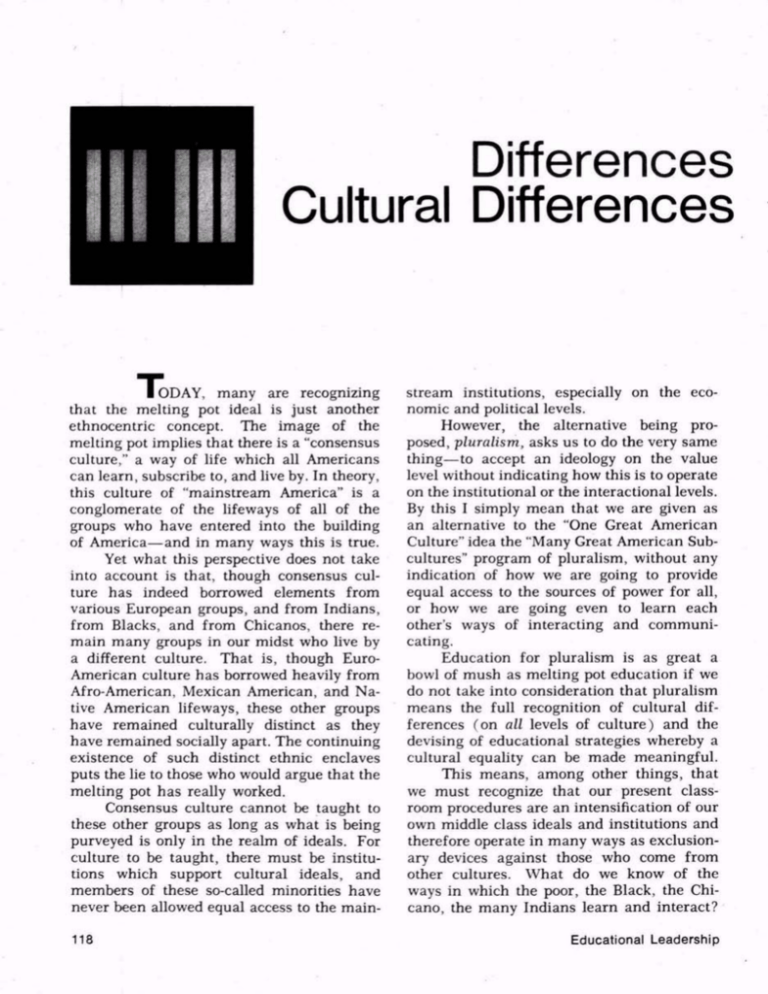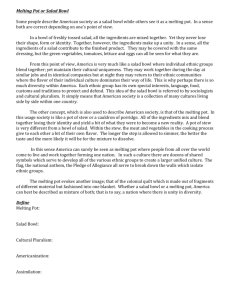
Differences
Cultural Differences
IODAY, many are recognizing
that the melting pot ideal is just another
ethnocentric concept. The image of the
melting pot implies that there is a "consensus
culture," a way of life which all Americans
can learn, subscribe to, and live by. In theory,
this culture of "mainstream America" is a
conglomerate of the lifeways of all of the
groups who have entered into the building
of America and in many ways this is true.
Yet what this perspective does not take
into account is that, though consensus cul
ture has indeed borrowed elements from
various European groups, and from Indians,
from Blacks, and from Chicanes, there re
main many groups in our midst who live by
a different culture. That is, though EuroAmerican culture has borrowed heavily from
Afro-American, Mexican American, and Na
tive American lifeways, these other groups
have remained culturally distinct as they
have remained socially apart. The continuing
existence of such distinct ethnic enclaves
puts the lie to those who would argue that the
melting pot has really worked.
Consensus culture cannot be taught to
these other groups as long as what is being
purveyed is only in the realm of ideals. For
culture to be taught, there must be institu
tions which support cultural ideals, and
members of these so-called minorities have
never been allowed equal access to the main
118
stream institutions, especially on the eco
nomic and political levels.
However, the alternative being pro
posed, pluralism, asks us to do the very same
thing to accept an ideology on the value
level without indicating how this is to operate
on the institutional or the interactional levels.
By this I simply mean that we are given as
an alternative to the "One Great American
Culture" idea the "Many Great American Sub
cultures" program of pluralism, without any
indication of how we are going to provide
equal access to the sources of power for all,
or how we are going even to learn each
other's ways of interacting and communi
cating.
Education for pluralism is as great a
bowl of mush as melting pot education if we
do not take into consideration that pluralism
means the full recognition of cultural dif
ferences (on a ll levels of culture) and the
devising of educational strategies whereby a
cultural equality can be made meaningful.
This means, among other things, that
we must recognize that our present class
room procedures are an intensification of our
own middle class ideals and institutions and
therefore operate in many ways as exclusion
ary devices against those who come from
other cultures. What do we know of the
ways in which the poor, the Black, the Chicano, the many Indians learn and interact?
Educational Leadership
and the Melting Pot Ideology
Melting Pot
ROGER D. ABRAHAMS *
Have we, as teachers, bothered even to learn
the ways in which we embarrass our students
by not understanding these cultural differ
ences much less the reasons that we cannot
teach them effectively?
What I am arguing is that if we are
(and I hope we are) really committed to a
pluralistic ideal of education, then we have
to recognize ahead of time what we are up
against in engineering change. And the one
fact that we must contend with is that there
is no case on record in the past in which
cultural pluralism of the sort we are dis
cussing has ever existed. That is, there is
no country that we know of which has a
cultural mix which does not have one dom
inant culture, the others subordinate at
least as far as access to the major economic
and governmental institutions. So if we are
to devise such a system it would be a unique
social experiment. The United States has,
however, engaged in such enterprises before.
What Happened to the Melting Pot?
One way of beginning is to see what was
wrong with the melting pot image. From
our contemporary perspective, the melting
pot implied a racist ideology because it never
included as part of the formula for the proper
mix the truly culturally different AfroAmericans, Chicanes, Indians, etc. These
November 1971
groups were never accorded status as full
human beings, so they were not considered
as fit candidates for the melting process. The
idea of the melting pot was a reaction to the
massive introduction of non-Anglo-Saxon
European immigrants to America in the last
half of the 19th century. Though aimed
ostensibly at extending American beneficence
and the American ideals hinging on individu
alism and rationalism, in retrospect the melt
ing pot argument looks suspiciously like a
knee-jerk reaction to the forming of Irish and
Southern and Eastern European ethnic com
munities within the East Coast cities. Such
ethnic communities, through their mainte
nance of community and language and cul
tural differences, threatened the fragile unity
of the nation. The melting pot ideology then
has always been an essentially nationalistic
one, and thus an argument subject to uses by
any group, benevolent or malevolent, which
preaches Americanism at the expense of
ethnic, regional, or even social class iden
tification.
Yet even with this nationalistic thrust,
used as an argument against the continuation
of linguistically and culturally different Euro
pean-Americans in the cities and towns,
* Roger D. Abrahams, Director, African and
Afro-American Research Institute, The Univer
sity of Texas at Austin
119
the practice of melting for the pot never
included the other (and darker) Americans
until the Civil Rights movement began. And
then it happened only because the members
of these ethnic communities suddenly de
manded to be recognized as human beings.
Before that time they were relegated to ani
mal status.
The reader will be saying at this, "Now
wait a minute! That is going too far." Per
haps it is, but let me demonstrate what I
mean. I do not mean that slavery and its
attendant chattel status continued to operate.
Rather, the dehumanization process func
tioned on a less legalistic plane, one we know
best through the operation of stereotyping.
The Operation of Stereotyping
What is stereotyping? It is primarily the
imposition of traits on a group which are pur
ported to be characteristic of the group. Now
occasionally these traits may be the result
of real observations on the part of the stereotypers. Blacks do h ave more rhythm, for
instance, because they have more compli
cated and overlapping rhythms in their
dances and songs. Yet even when these cul
tural differences are observed, the question
is what we do with them. With Black rhythm,
for instance, we tie this in with a certain
earthiness and by extension to a basically
immoral (or amoral) and childlike per
spective.
The other stereotype traits imposed on
Blacks ( and other "minorities" and groups of
poor people) all revolve around these pri
mary traits of childishness and immorality.
Laziness, thievery, inability to contain sexual
urges, strange eating habits, having too many
children and raising them without any sense
of proper family life all of these and more
emphasize the inability of members of the
group to live by the proper rules.
The implication (sometimes it becomes
an explication) is that people from these
groups have no sense of order. -Now c ulture
is, if nothing else, the agreed upon ways in
which a group orders things the rules and
manners of the group. If members of a group
have no sense of order, then they have no
120
"In devising a pluralistic perspective, the
task is to question and investigate cul
tures without totally rejecting one's own."
culture, and the acquisition of culture is
what divides adults from children and hu
man beings from animals. So when the
stereotype is involved, it means that the
stereotypers are assuming that the stereo
typed are a group of children or animals
without actually always saying so. And de
nning a group as culturally deprived or disadvantaged does exactly the same thing
it defines the culturally different by our own
norms and finds them lacking.
Any time members of a group are
derogated in regard to where they depart
from another group's norms and practices,
they are being stereotyped. Until very re
cently, this was the only approach to Blacks
and other culturally different groups by an
overwhelming majority of Euro-Americans,
an approach institutionalized in our educa
tional system (except in rare cases). This
is what I meant when I said that non-EuroAmericans have been treated as animals
not wild ones, but the kind we like to keep
around the house and yard.
Today suddenly the bases of stereotyp
ing are eliminated and we can no longer
generalize on such groups (at least officially).
And so now the old melting pot ideology is
trotted out, for if these others are human
beings they must be assimilable. The ethnic
Euro-Americans that have been thus as
similated now preach, "We have done it; why
can't you?" The answer, of course, is why
should they have to? By any standard of
equality, being forced to adhere to an alien
cultural mold is both iniquitous and, without
structural changes in national institutions
and goals, clearly impossible.
Cultural Relativism in the Schools
This position of cultural relativism
which I am espousing for the schools is a
difficult one to accept at best, for it means
Educational Leadership
questioning the absoluteness of our own
values and practices. In the task of devising
a pluralistic perspective, it is equally as im
portant to maintain one's own cultural sense
as it is to recognize that of others.
One of the major by-products of adopt
ing the relativistic position is that one begins
to question the values of one's own culture,
when one sees that one's values and practices
are not immutable and the only right solu
tions to our human problems. To reject out
of hand one's own values is folly indeed.
One cannot educate effectively without a
firm knowledge of oneself. The task, then,
is to question and investigate cultures with
out totally rejecting one's own and develop
ing a defeating sense of self-doubt.
A procedure which my colleagues, Mary
Galvan and Rudolph Troike, and I (of the
Texas Education Agency's East Texas Dialect
and Culture Project) have found meaningful
is to teach other cultural ways by making
teachers more conscious of their own culture.
First of all, this means that we must demon
strate how deep stereotyping goes, and that
this is just one way people with culture
project and protect their own sense of groupness and sharing. Then, however, it is neces
sary to show that we live by a lot of other
unexamined ordering processes, especially by
rules of interaction those ways in which we
make haphazard behavior into ordered man
ners or decorum.
To show how deeply rule-involved we
are and how much of our sense of personal
worth depends on living by these rules, we
attempt to embarrass each other. It is only in
embarrassment situations that we can dem
onstrate how we have learned and internal
ized certain practices, developing expectations
for a wide range of interactions, and how
much we are threatened when these expecta
tions and orders are broken.
Then, because we are dealing with
teachers who minister to both Afro- and
Euro-American students, we demonstrate
how patterned and predictable the ways are
in which the two cultures do not fit, pro
ducing the same embarrassment situations
repeatedly. To get this message through,
however, we must convince the teachers that
their students, no matter what age or color,
have culture and can therefore be embar
rassed. To do this, we describe Black lan
guage use, both in terms of phonological and
morphological differences and in the ways
language is utilized in personal exchanges.
We also cover what is known about AfroAmerican culture, not only in speech use but
in child-rearing and family patterns, peer
grouping, religion, allocation of time and
money, and so on. To do this we give over
a large part of our in-service programs to
teaching teachers how to observe, notate,
and use language and cultural differences.
Our aim throughout is to permit recog
nitions of differences at all levels of culture.
Only by developing the powers of observa
tion about oneself and others will it be pos
sible to regard the culturally different as
culturally different and nothing more. In
this sense a truly pluralistic education will
provide the most profound American Revo
lution in 200 years.
Q
On Early Learning:
The Modifiability of Human Potential
By IRA J. GORDON
51 Pages
Stock Number: 611-17842
$2.00
Association for Supervision and Curriculum Development
1201 Sixteenth Street, N.W., Washington, D.C. 20036
November 1971
121
Copyright © 1971 by the Association for Supervision and Curriculum
Development. All rights reserved.







